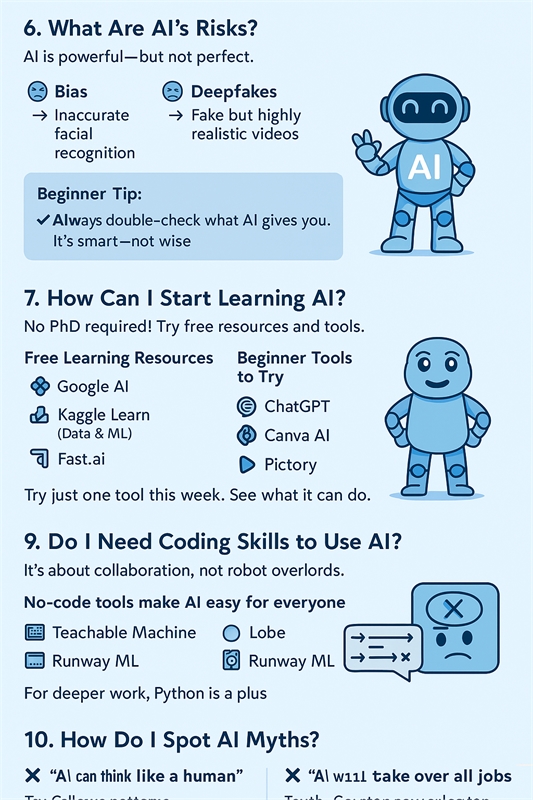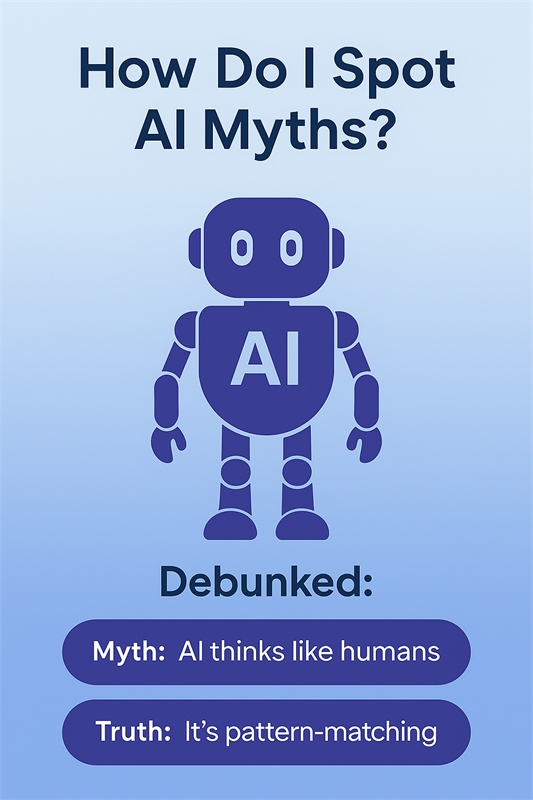Welcome to AI Grand Central, where we make artificial intelligence easy to understand — no tech degree required. If AI sounds overwhelming, you’re not alone. This post answers the most Googled questions about AI in plain English, with examples, visuals, and zero fluff.
🔍 1. What Is AI?
Artificial Intelligence (AI) is just a fancy way of saying “machines doing smart stuff.”
If a computer can make decisions, learn from experience, or even hold a conversation — that’s AI.
✅ Real-world examples:
-
Siri or Alexa: Voice assistants that respond like people.
-
Netflix recommendations: AI suggests what to watch based on your tastes.
-
Google Maps: Predicts the best route by learning from traffic data.
🤓 Beginner Tip:
Think of AI as your super helpful sidekick, not a scary sci-fi robot.
📸 Visual Prompt: [Insert Image: “What is AI?” infographic showing Siri, Netflix, and Google Maps as use cases]
🧠 2. How Does AI Work?
Let’s keep this simple.
AI uses data + math = predictions. It learns from examples — just like you learned to ride a bike (or avoid stepping on LEGO bricks).
🎯 Metaphor:
Think of AI like training a dog. You show it how to sit, give a treat when it gets it right, and over time — boom — it learns.
⚙️ A Few Ways AI Learns:
-
Algorithms: Step-by-step rules that help it make sense of the world.
-
Training data: Tons of examples it learns from.
-
Feedback: Correct answers help it adjust and get better over time.
🧩 3. What Are the Types of AI?
Not all AI is created equal. Some are smart... others are scary-smart. Here's the breakdown:
🧠 1. Narrow AI (a.k.a. Weak AI)
This is the kind of AI we use every day — it’s great at one thing.
Examples:
🚀 2. General AI
AI that can do anything a human can do — but it doesn’t exist yet. If it ever does, think Iron Man’s J.A.R.V.I.S. or HAL from 2001: A Space Odyssey.
🤖 3. Super AI
Sci-fi level AI that’s smarter than all humans combined. Also not real. Yet. (Let’s hope it likes us.)
📸 Visual Prompt:
[Insert visual: "3 Types of AI" chart — Narrow AI (real), General AI (future), Super AI (theoretical)]
📱 4. How Is AI Used in Daily Life?
AI’s not coming — it’s already here. You’re using it right now, whether you realize it or not.
💡 Everyday AI Examples:
-
Smart assistants (like Siri or Alexa)
-
Maps & GPS apps (predicting traffic)
-
Fraud detection (your bank stopping sketchy charges)
-
Social media feeds (deciding what you see first)
📊 Use Case Table:
AreaHow AI Helps🏥 HealthcareAI scans X-rays and helps diagnose diseases🛍️ RetailPersonalized ads and product suggestions🚗 NavigationGoogle Maps predicts traffic & reroutes you🎧 EntertainmentSuggests shows/music you’ll probably like📧 EmailSpam filters & smart replies
🧠 Beginner Tip:
If it’s saving you time or predicting your next move, there’s probably AI behind it.
📸 Visual Prompt:
[Insert graphic: “AI in Everyday Life” with icons for health, shopping, traffic, email]
🤖 5. Will AI Replace Jobs?
Let’s get real — AI is changing the workplace. But replace everyone? Not likely.
Here’s what’s actually happening:
-
AI automates tasks, not whole careers.
-
New roles are popping up — like AI ethicist, prompt engineer, and automation strategist.
💬 Reality Check:
🧾 IBM reports that 85% of jobs will change, not vanish.
💼 AI may take repetitive tasks, but it also creates opportunities for creative, strategic, and people-focused roles.
👷 Jobs at Risk:
-
Data entry
-
Basic customer service
-
Routine scheduling
💼 Jobs Being Created or Transformed:
🚀 Pro Tip:
Learn how to use AI — it’s a career boost, not a threat.
⚠️ 6. What Are AI’s Risks?
AI is powerful — but not perfect. Like anything else, it can cause problems if misused or built without care.
🛑 Common AI Risks:
-
👤 Bias: Some facial recognition tools struggle to accurately identify people of color.
-
🎭 Deepfakes: Fake videos that look very real — often used in scams.
-
🤖 Misinformation: AI might “hallucinate” facts and sound confident while being wrong.
🧠 Beginner Tip:
Always double-check what AI gives you. It’s smart — not wise.
📸 Visual Prompt:
[Insert visual: “Risks of AI” with icons for bias, deepfakes, misinformation]
🧪 7. How Can I Start Learning AI?
No PhD required! There are tons of beginner-friendly tools and resources that teach AI by using it.
📚 Free Learning Resources:
-
Google AI Learning
-
Kaggle Learn (Data & ML)
-
Fast.ai
🧰 Beginner Tools to Try:
-
ChatGPT — Ask questions, brainstorm, summarize.
-
Canva AI — Generate images and text for design.
-
Pictory — Turn text into videos.
🎯 Try just one tool this week. See what it can do. You'll learn fast by doing.
🔮 8. What’s the Future of AI?
The future isn’t about robot overlords — it’s about collaboration.
🌟 Trends to Watch:
-
Smarter virtual assistants that handle complex tasks
-
Ethical AI debates — like how to avoid bias or misuse
-
AI + Creativity — helping write, design, and build faster
🚀 Think of AI as a power tool — in the right hands, it speeds things up.
📸 Visual Prompt:
[Insert graphic: “What’s Next in AI?” with a timeline or icons showing evolution]
💻 9. Do I Need Coding Skills to Use AI?
Short answer? Nope.
AI tools are getting easier and more visual. You don’t need to know Python to start.
🧠 No-Code AI Tools:
-
Teachable Machine – Create image/audio classifiers.
-
Lobe – Train models using drag-and-drop.
-
Runway ML – AI video tools, no code required.
But if you do want to go deeper, learning some Python basics can open even more doors.
📸 Visual Prompt:
[Insert visual: “No-Code AI Tools” with screenshots or logos]
🧯 10. How Do I Spot AI Myths?
Let’s bust a few of these open:
🕵️ Common Myths — Debunked:
-
❌ “AI can think like a human”
➤ Truth: AI follows patterns — it doesn’t understand like we do.
-
❌ “AI will take over all jobs”
➤ Truth: It changes how we work, but creates new roles too.
-
❌ “AI is 100% accurate”
➤ Truth: It makes mistakes, especially with limited or biased data.
🧠 Always ask: Who trained this AI? On what data? If you don’t know — question the output.
📸 Visual Prompt:
[Insert chart: “Top 3 AI Myths vs. Reality”]
🎉 Conclusion: You’re Smarter Than You Think
AI can sound intimidating — but now you know more than most. Use that momentum.
🔗 Next Step: Explore real tools on AI Grand Central to start learning by doing.
🚀 Try These Starter Tools: